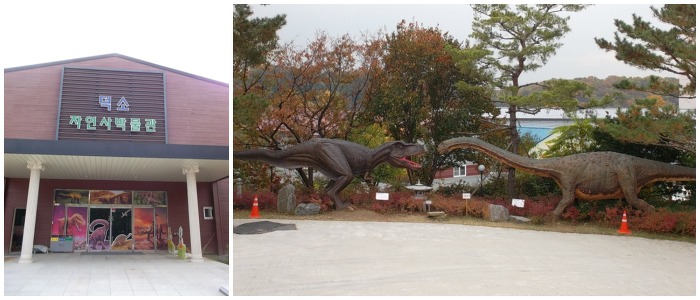Tyrannosaurus met in Deokso Museum of Natural History
Createdd 2014-12-01 Hit 1512
Contents
In Gyeonggi Province, there is a museum of natural history that is run privately without support from cities or the province. It is the Deokso Museum of Natural History, located in Wabu-eup of Namyangju City. The Deokso Museum of Natural History is an exemplary museum that exhibits thousands of natural history objects gathered from over 30 countries around the world, including minerals, insect specimens, fish and shellfish, and fossil specimens. These natural history collections are displayed in several categories skillfully arranged by experts.

The admission fees were a little bit higher than other general national museums. It was KRW 7,000 for an adult, and KRW 6,000 for a child. For a family of three or more, a discount of KRW 5,000 was offered.

The Deokso Museum of Natural History houses a massive number of natural history objects, including 5 authentic fossilized dinosaurs, some 500 fossil specimens, 350 mineral specimens, 20 pieces of Hwamunsuk, 30 speleothems, 90 pieces of suiseki, 2,000 shellfish, 200 taxidermy fish, 90 taxidermy animals, 1,200 insect specimens, 30 botanical specimens, 50 silicified woods, and 50 pieces of Cenozoic mammals skeletons.

The gigantic fossilized dinosaur greeting us at the entrance is a stegosaurus. It was an herbivorous dinosaur that fed on leaves. It is amazing that leaves were the staple for such a gigantic dinosaur. Its name means “roof lizard,” and ‘stego’ refers to its bony plates.

The stegosaurus had a hard mouth but small and weak teeth. Despite its huge size, it had a very small brain of about 70 grams, the weight of an egg; therefore, people estimate that it was one of the least intelligent and slowest dinosaurs. The four tail spikes were used as a weapon to protect the stegosaurus from carnivorous animals.


The first exhibition hall featured minerals. There were large white crystals, and the sizes were amazing. They looked no different than common stones to me. Why do they look so beautiful to women? How about you?

This mineral that looks like a miniature of the island where Robinson Crusoe was stranded is a stalagmite. Formed through the accumulation of calcareous material deposited on the ground from ceiling drippings, the stalagmite features the gorgeous shape of a forest as if it were artificially made.

A mineral is a naturally occurring solid substance that has a certain chemical composition and an ordered atomic structure. Approximately 3,700 types of minerals have been closely associated with human beings since prehistoric times. Minerals are largely divided into two categories – precious stones and industrial materials – and some of the most representative minerals include feldspar, quartz, and calcspar.

This is the stegodon that we encountered on our way to the dinosaur exhibition hall on the second floor. Stegodons, which resemble elephants, are believed by some scholars to be the ancestors of elephants and mammoths. Dinosaurs are a group of reptiles that existed on earth during the Mesozoic Era from 250 million years ago until 65 million years ago. Dinosaurs were terrestrial animals with two pairs of openings in the skull behind the eyes, and limbs held erect beneath the body which enabled them to walk upright.

The fossilized remains of a tyrannosaur, a brachiosaur, and a pteranodon were displayed in the dinosaur exhibition hall. After viewing the fossilized skull of a tyrannosaur, when we walked up the dark stairs marked ‘Black Hole,’ we were startled by a loud bang and lights that suddenly started circling the dark alley. It was a black hole through which we traveled to the world of dinosaurs. The tyrannosaur encountered right after we emerged from the black hole gave an unexpected cry; it was so dynamic and realistic that we were all startled.


This is a fossil of a very cute bird in the fossil exhibition hall. Not all dinosaurs were big and scary. How could such a small creature become fossilized? The bird looks so real that it almost jumps out of the fossil. I felt like I could hear it singing. I also thought that it would be nice to put such a cute bird fossil on the wall of a house.

This smilodon is like one I saw in an animated movie when I was little. The name has the meaning of “saber-tooth.” The two saber-teeth must have been very useful for hunting. The smilodon is estimated to have been around the size and shape of a modern lion or tiger.


The insect and plant exhibition hall of the Deokso Museum of Natural History houses approximately 1,000 insect and botanical specimens collected from 10 countries around the world. Numerous samples of stag beetles, spiders, moths, and butterflies were on display. I thought butterflies would be the most beautiful of them all, but I found the moths very beautiful, like those we could see in animated movies.

Dinosaurs are also displayed in the outdoor exhibition area, including a tyrannosaur and a deinonychus. Deinonychus, meaning ‘terrible claw,’ grew to be only 3 to 4 meters in length, but it was smart, hunted as a group, and never missed its prey.

At the experiential learning center, a program titled ‘Fossils, come out, come out, wherever you are’ was being offered by the Kkumdarak Weekend Culture School, but we couldn’t participate because advance registration is required. They said it is an educational program in which participants find answers to questions about fossils through field trips, exploring and reconstructing fossils and fossil sites. Offering informative and useful experiences for children, the Deokso Museum of Natural History is where children can find answers to their questions about dinosaurs and insects, and where they can see and feel minerals and fossilized dinosaurs previously only experienced in books. For parents of future scientists and geologists, the Deokso Museum of Natural History is a must-visit place with children.
http://ggholic.tistory.com/9345



















